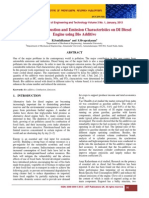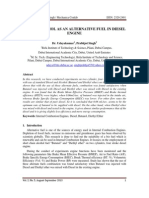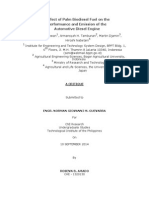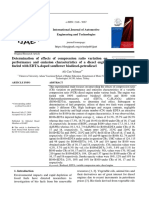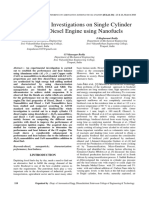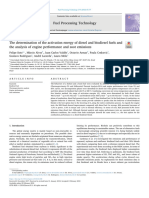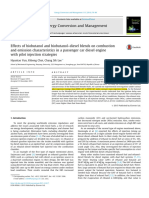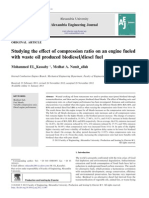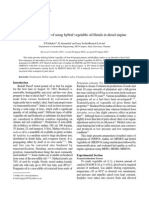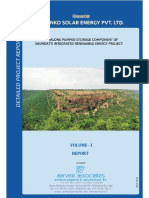Performance Analysis and Emissions Profile of A Diesel Generator Powered With Additivated Blends of Diesel, Biodiesel and Ethanol
Performance Analysis and Emissions Profile of A Diesel Generator Powered With Additivated Blends of Diesel, Biodiesel and Ethanol
Uploaded by
Arthur MagalhãesOriginal Description:
Original Title
Copyright
Available Formats
Share this document
Did you find this document useful?
Is this content inappropriate?
Report this DocumentCopyright:
Available Formats
Performance Analysis and Emissions Profile of A Diesel Generator Powered With Additivated Blends of Diesel, Biodiesel and Ethanol
Performance Analysis and Emissions Profile of A Diesel Generator Powered With Additivated Blends of Diesel, Biodiesel and Ethanol
Uploaded by
Arthur MagalhãesCopyright:
Available Formats
22nd International Congress of Mechanical Engineering (COBEM 2013)
November 3-7, 2013, Ribeiro Preto, SP, Brazil
Copyright 2013 by ABCM
PERFORMANCE ANALYSIS AND EMISSIONS PROFILE OF A DIESEL GENERATOR
POWERED WITH ADDITIVATED BLENDS OF DIESEL, BIODIESEL AND ETHANOL
FERREIRA, Vitor Pinheiro
1
TORRES, Ednildo Andrade
2
1
UFRB Federal University of Recncavo of Bahia
vitorpferreira@gmail.com
2
UFBA - Federal University of Bahia
ednildo@ufba.br
SODR, Joo Matteus
3
UFBA Federal University of Bahia
joaomatt@hotmail.com
da CUNHA, Davi Perna Martins
4
UFBA Federal University of Bahia
davi.perna@hotmail.com
CORREIA, Guilherme DEmdio
5
UFBA Federal University of Bahia
gdcorreia@gmail.com
Abstract. Environmental concern with the use of fossil resources motivates several researches to find out substitutes to
petroleum products, in particular for diesel oil. Biodiesel stands out for being renewable, nontoxic and easily
degradable. The use of this fuel is suitable for Diesel engines with little or no physical modifications. Furthermore,
biodiesel has some disadvantages such as higher viscosity, low volatility, and higher emissions of nitrogen oxides
(NO
x
) when compared to mineral diesel. This paper shows the results for the mechanical performance and emissions
profile of a diesel engine operating with blends of diesel, biodiesel and ethanol. The tests occurred in a single cylinder
diesel generator with mechanical indirect injection at 1800 rpm that powered a resistive electric panel. Four different
fuels were tested: B5 (95% diesel, 5% biodiesel v/v), B50 (50% diesel, 50% biodiesel v/v), 92%B50+8%E (46% diesel,
46% biodiesel, 8% ethanol v/v). Finally, other composition was tested with the use of a cetane improver (DTBP: di-
tert-butyl peroxide) in a ratio of 0.5% (91.54%B50+7.96%E+0.5%A). The compositions were prepared using the S-10
diesel oil and soybean biodiesel. The Tests occurred at low load conditions. Emissions profile, specific fuel
consumption and energy analysis were evaluated. It was noticed a decreasing in energy efficiency, NO
x
and CO
emissions with increase in ethanol content and increasing of NO
x
emissions with Biodiesel addition. The use of DTBP
showed a slight increase in energy efficiency, but an increasing in NO
x
and CO emissions was noticed. Considerations
for future use of ethanol in diesel engines are presented.
Keywords: Diesel engines, ethanol, biodiesel, ternary blends.
1. INTRODUCTION
Biodiesel has been widely proposed as a substitute for mineral diesel fuel. This fuel virtually does not generate
residues of sulfur and has lower emissions of other pollutants due to the presence of the oxygen in its molecules (Qi, et
al., 2006; Lin, et al., 2007). However, the use of biodiesel leads to a consistent increase in emissions of nitrogen oxides
(NO
x
) (Sandumet al., 2005; Lapuerta et al., 2008). Several solutions to this problemare generally used, such as exhaust
gas recirculation (EGR) and the addition of oxygenated compounds such as ethyl and methyl alcohol or dimethyl ether
(DME) (Yilmaz and Sanchez, 2012; Jie et al., 2010; Yao et al., 2007).
Yao et al. (2007) studied the effect of methanol injected into the intake air of a diesel engine. It was found reduction
in NO
x
and PM emissions with addition of methanol.
The possibility of using oxygenated compounds, such as ethanol, motivates the study of these compounds in diesel
engines, considering that this fuel can be produced frombiomass on a large scale in countries with high agricultural
potential, such as Brazil. Montero and Stoytchevap (2011) comment that ethanol can increase the percentage of biofuel
in the blend as well as improve the gas emissions profile when compared to mineral diesel.
The use of ternary mixtures of diesel, biodiesel and ethanol can simultaneously reduce NO
x
and particulate matter
(PM) emissions (Lei et al., 2010). However this requires a limited amount of ethanol (up to 10% v/v) due to the
miscibility problems of ethanol in diesel fuel, unless solubility additives are used (Lapuerta et al., 2007). Guarieiro et al.
ISSN 2176-5480
1555
FERREIRA, V.P.; TORRES, E.A.; SODR, J .M.C.; Martins, D.P.; CORREIA, G.D.
Performance Analysis of a Diesel Generator Powered with Blends of Diesel, Biodiesel and Ethanol.
(2009) tested the stability of 18 binary and ternary blends of diesel, vegetable oils, biodiesel and ethanol for a minimum
period of 90 days and found that the mixtures of ethanol with purity of 95% were not stable due to the polarity of the
water molecule present in this compound. The blends were stable up to fractions lower than 10% of ethanol with purity
of 99.5%.
Huang et al. (2009) studied the stability, emissions profile, energy efficiency and fuel consumption of diesel and
ethanol blends aditioned with n-butanol. The results showed that the additive n-butanol improved the blend solubility. It
was found an increase in fuel consumption, CO and THC emissions. The NO
x
emissions were not conclusive.
This present work shows and discusses the results of emissions profile tests with binary and ternary blends of diesel,
biodiesel and ethanol in a diesel engine. The aimis to reduce NO
x
emissions, while increasing the percentage of
renewable fuel in the combustible mixture.
2. MATERIALS AND METHODS
The tests were conducted in a three-phase generator manufactured by Kohlbachpowered by a single cylinder 4-
stroke diesel engine, manufactured by Agralewith indirect injection and maximum power of 10 HP. The engine and
generator properties are described in Tab. (1) and (2). The tests occurred in conditions of same load for each fuel (1580
10 W). The amount of main fuel supplied by the high pressure injector pump was regulated for each fuel to produce
the same engine speed (1800 rpm).
Table 1. Engine Properties
Property Engine
Maximum Power (kW) 7.6 (NBR-1585)
Speed (rpm) 1800-2500
Compression ratio 20:1
Number of Cylinders 1
Injection type Indirect
Injection Pressure (MPa) 15
Sweep volume (cm
3
) 567
Table 2. Generator Properties
Property Generator
MaximumPower (kVA) 6.0
Nominal speed (rpm) 1800
Voltage 3~/ 220V/ 60Hz
2.1. Instrumentation
The mass fuel flow was obtained by the gravimetric method using a digital scale. For each fuel, five cycles of
consumption measurements were performed with a sampling time of 30 min. The generator power was obtained using a
digital wattmeter with a sampling frequency of 3Hz.
The exhaust gases were determined through a gas analyzer that was able to evaluate the concentrations of CO
2
(%),
CO and NO
x
in ppm. A total of 25 measurements of gas emissions were done for each fuel. The main characteristics of
the employed instruments are shown in Tab. 3.
Table 3. Properties of the Main Instruments
Property Instrument model
(manufacturer)
Measurement
uncertainty
Air Temperature Thermometer AN-3070 (Icel) (3%+0.2) C
Relative Humidity Digital Thermohygrometer HT-208
(Icel)
3%
Exhaust Gas Analysis
(NO
x
, CO and CO
2
)
Gas Analyzer Tempest-100
(Telegan Gas Monitoring)
2%
Electric Power (W) Digital Wattmeter AW-4700 (Icel) (3% +5 dig.)
Fuel Consumption
(diesel+biodiesel+ethanol)
Digital scale 9094 (Toledo)
2 g
ISSN 2176-5480
1556
22nd International Congress of Mechanical Engineering (COBEM 2013)
November 3-7, 2013, Ribeiro Preto, SP, Brazil
2.2. Fuels and Additive
The class S-10 diesel, ethyl alcohol 99.2% purity and soybean biodiesel blend used to make up the fuel
compositions were kindly donated by Petrobahia (Petroleum Distributor of Bahia S.A.). Tab. 4 shows the main
characteristics of the raw materials used for the fuel compositions.
Table 4. Raw Material Properties for Fuels.
Property Fossil Diesel Soybean Biodiesel Ethyl Alcohol
Typical composition C
9.84
H
17.95
C
18.74
H
34.43
O
2
C
2
H
6
O
Weight molecular
(kg kmol
-1
)
136.3 291.77 30.1
Density at 20C 0.853 0.870 0.790
Latent heat of
vaporization (kJ kg
-1
)
270 200 840
Cetane number 48 56 6
Stoichiometric ratio
(kg air/kg of fuel)
14.6 12.5 9
Lower heating value
(kJ kg
-1
)
42820 36395 28300
Four different fuel compositions were tested. The tests started with a commercial binary mixture of 95% v/v mineral
diesel and 5% v/v biodiesel (B5). After that, two compositions were tested (B50, 92%B50+8%E)
The di-tert-butyl peroxide (DTPB), similarly to the 2-ethylhexylnitrate (2-EHN), is a known accelerator for
spontaneous ignition and has been used as a cetane improver of diesel fuel in recent researches (Lee et al., 2010). Tab. 5
shows the properties of (DTPB). The use of DTBP additive in a percentage of 5000 ppm(0.5%) can increase the cetane
number of standard diesel fuel from48 to 53.5 (EPA, 2004).
Table 5. Properties of DTBP (di-tert-butyl peroxide).
Property Value
Composition C
8
H
18
O
2
Flash Point (C) 6
Density (20C) 0.79
Autoignition Temperature (C) 165
In this study the additive di-tert-butyl peroxide, supplied by Merck, was added in a ratio of 0.5% in volume in
order to increase the cetane number of the ternary blend (92%B50+8%E) performing the fourth fuel composition
(91.54%B50+7.96%E+0.5%A).
2.3. Energy Analysis
The tests took place within an ambient temperature of 30 2 C, while the relative humidity was constant at 55 3
%. For each cycle, the engine was heated for 30 minutes. Lubricating oil was substituted for each fuel composition. The
lubricating oil was Lubrax CI-4 (15W-40) manufactured by Petrobras.
The combustion reaction is described in Eq. (1).
(1)
The x, y and z coefficients are the fractions used in each fuel of the ternary mixture (x+y+z=1), while the other
coefficients (a, b, c, d, e, f, g and h) were obtained using the measured data, and the mass balance of each element.
For the energy analysis some assumptions were made:
- The engine operates at steady state;
- The control volume includes the engine and the generator;
2 2 2 2 2
N h NO g NO f O e O H d CO c CO b + + + + + +
+ + + + ) 76 . 3 (
2 2 6 2 2 43 . 34 74 . 18 95 . 17 84 . 9
N O a O H C z O H C y H C x
ISSN 2176-5480
1557
FERREIRA, V.P.; TORRES, E.A.; SODR, J .M.C.; Martins, D.P.; CORREIA, G.D.
Performance Analysis of a Diesel Generator Powered with Blends of Diesel, Biodiesel and Ethanol.
- The inclusion of additive does not modify the heating value of the fuel;
- The blends are ideal solutions;
- The kinetic and potential energy effects were not taken into account;
- The atmospheric air composition was assumed as 21% oxygen and 79% nitrogen on a molar basis;
- The unburned hydrocarbon concentrations, as well as SO
2
, were not considered.
The specific fuel consumption (SFC), defined as the ratio between the total fuel consumed mass and the consumed
energy, at a specific time and evaluated in g/kW.h, was obtained as in Eq. (2).
(2)
Where:
m
e
is the is the mass of ethanol during each cycle in kg;
m
d
is the is the mass of diesel in each cycle in kg;
m
b
is the is the mass of biodiesel in each cycle in kg;
-
vc
W
is the average of instantaneous power, measured in kW
t is the sampling time in hours.
For determination of heat exchanged between the engine and the ambient, the First Law of Thermodynamics was
applied to the engine in a steady state, as shown in Eq. (3) (Moran and Shapiro, 2009).
(3)
Where:
VC
Q
is the heat flow crossing the control surface (losses) in kW;
c
n is the fuel molar flow in kmol/s;
p
h
is the molar combustion enthalpy in combustion gases in kJ/kmol;
R
h
is the reactants combustion enthalpy in kJ/kmol;
The energy in the exhaust gas was determined by Eq. (4):
(4)
Where:
d
Q
is the energy lost by the exhaust gas fromthe control surface in kW;
PCI
is the molar lower heating value of fuel in kJ/kmol.
The generator energy efficiency () defined as the ratio of useful energy produced by the generator and the
contained energy in the consumed fuel was determined according to Eq. (5).
(5)
Where:
LHV
e
is the ethanol lower heating value in kJ.kg
-1
;
LHV
d
is the lower heating value of diesel fuel in kJ .kg
-1
;
LHV
b
is the lower heating value of biodiesel fuel in kJ.kg
-1
;
t A is the sampling time in h.
3. RESULTS
3.1. NO
x
/CO Emissions
( )
VC R p c VC
W h h n Q
+ =
VC VC c d
Q W PCI n Q
= ) (
t W
m m m
SFC
vc
b d e
A
+ +
=
-
.
100
.
(%)
|
|
.
|
\
|
+ +
A
=
b b d d e e
vc
LHV m LHV m LHV m
t W
ISSN 2176-5480
1558
22nd International Congress of Mechanical Engineering (COBEM 2013)
November 3-7, 2013, Ribeiro Preto, SP, Brazil
The results for NO
x
and CO emissions are shown in Fig. 1. These results are the variations in emissions for each fuel
when compared to B5 blend, measured in ppm (v/v). NO
x
emissions are mostly related to the maximum temperatures
obtained within the combustion chamber during combustion, but oxygen in the fuel may also increase the NO
x
emissions in Diesel engines. It is possible to sse in Fig. 1 that the highest NO
x
emissions occurred with the use of the
biodiesel, probably due to the higher amount of oxygen present in this fuel. The addition of ethanol caused a reduction
in NO
x
emissions. The addition of a fuel with a very low cetane number is expected to significantly increase ignition
delay, so producing the peak pressure at a later stage, resulting in a decreasing of combustion chamber pressure and
temperature as discussed by Park et al. (2011) who observed that increasing of ethanol content in diesel oil increases the
ignition delay. Additionally the high latent heat of vaporization of ethanol can induce temperature reduction in the
combustion chamber, as described by Zhu et al. (2011) who tested the effect of ethanol in biodiesel blends.
Figure 1. Variation in CO and NO
x
emissions for each fuel related to D95B5 blend (ppm).
According to other authors (Randazzo and Sodr, 2011) since the small low heating value of ethanol in comparison
with diesel oil, higher fuel amounts are required to produce the same power from the engine, thus intensifying fuel
vaporization and reducing the temperatures attained in the combustion chamber, thereby reducing the NO
x
emissions.
Carbon monoxide is generally formed when the engine operates in a rich environment of fuel/air mixture. The
carbon monoxide emissions in Fig. 1 show a consistent decrease with the addition of biodiesel, since this fuel has
oxygen in its molecules. The addition of ethanol shows a slight increase in CO emissions, probably due to the fact that
the ethanol addition decreases the overall biodiesel content in the fuel mixture. The reduction in cetane number with
ethanol introduction can increase the CO emissions.
DTBP does not have nitrogen in its composition such as others cetane improvers (2-EHN) but, the induced reduction
of the ignition delay of the combustion will increase the combustion pressure and temperature. This may be the reason
why the use of the additive led to a very slight increase in NO
x
emissions when compared to ternary blend with ethanol
(92%B50+8%E). The use of DTBP caused an increasing in CO emissions. Other authors found different results (Nandi
and Jacobs, 1995).
3.2. CO
2
Emissions
Figure 2 shows the results for CO
2
emissions. These results are the variations in emissions for each fuel when
compared to B5 blend, measured in % (v/v). There is no appreciable variation in CO
2
emissions with increasing ethanol
and biodiesel content. The gas analyzer uncertainly (0.2%CO
2
) can make impossible to measure the variation in CO
2
emissions with ethanol introduction. Since ethanol is a renewable fuel, this CO
2
amount can be reused in the
photosynthesis process of the plants, thus the use of ethanol in Diesel engines can be an important strategy to control
global warming.
ISSN 2176-5480
1559
FERREIRA, V.P.; TORRES, E.A.; SODR, J .M.C.; Martins, D.P.; CORREIA, G.D.
Performance Analysis of a Diesel Generator Powered with Blends of Diesel, Biodiesel and Ethanol.
Figure 2. Variation in CO
2
emissions related to B5 (%).
3.3. Energy Analysis
Figure 3 shows the total specific fuel consumption for the four fuel compositions. As shown in Fig. 3, a consistent
increase in the total specific fuel consumption with biodiesel and ethanol content can be seen. Biodiesel and Ethanol has
low calorific values, thus to maintain the same output power, the total fuel consumption tends to be higher than the
binary blend B5. The use of the additive leads to a very slight reduction in the total fuel consumption, since it can
increase the combustion performance.
Figure 3. Results for total specific fuel consumption.
Table 6 shows the energy flows entering and leaving the engine for the four tested fuels.
Table 6. Results for Energy Analysis.
Energy Flow
(kW)
Fuels
B5 B50 92%B50+8%E 91.54%B50+7.96%E+0.5%A
Input Energy 9.38
9.35
9.39
9.37
Electric Power 1.58 1.58 1.58 1.58
Losses 5.78
5.62
5.78
5.78
Exhaust Gas Heat 2.02
2.08
2.03
2.01
ISSN 2176-5480
1560
22nd International Congress of Mechanical Engineering (COBEM 2013)
November 3-7, 2013, Ribeiro Preto, SP, Brazil
The input energy values are similar for all fuels. The low heating value in B50, 92%B50+8%E and
91.54%B50+7.96%E+0.5%A blends is compensated by the surplus mass given by the high fuel consumption of blends
with ethanol and high biodiesel amount. The biodiesel shows the highest amount in exhaust gas heat, since this fuel can
increase the exhaust gas temperature. There is a noticeable amount of energy in exhaust gas and losses in the
engine/generator surface for all fuels. Further studies for heat recover of these energy fractions are justifiable.
The results for energy efficiency of the engine for each fuel tested are shown in Fig. 4. The efficiency calculation
refers to overall efficiency of the engine-generator set, thus taking into account the losses of the mechanical
transmission added to those caused by the Joule effect in the generator and electrical power cables.
The B50 mixture presented increased energy efficiency due to the higher cetane number of the two materials with a
higher numeric value of this property. Oxygen in biodiesel molecule can increase the energy efficiency. Its possible to
note a slight reduction in energy efficiency with increasing ethanol content in the fuel composition. This occurs because
of the low cetane number of ethanol, as shown in Tab. 4. This reduction was not significant, when taking into account
the fact that ethanol has a low calorific value and a cetane number which is much lower than that of diesel and/or
biodiesel. The oxygen in the ethanol molecule can improve the combustion process. The reduction in specific fuel
consumption with addition of DTBP caused a very small increase in engine energy efficiency, although the
measurement uncertainty makes reliable conclusions impossible.
Figure 4. Energy Effciency for each fuel.
4. CONCLUSIONS
The use of ethanol can be a valuable alternative to reduce NO
x
emissions when using biodiesel as fuel in
compression ignition engines. Furthermore, ethanol can help to reduce the consumption of fossil fuel resources.
The results for an engine emissions profile operating with diesel-biodiesel-ethanol blends were presented. The
results for energy efficiency shown that biodiesel caused an improving in the engine efficiency, since this fuel has
higher cetane number and oxygen content than mineral diesel.
The NO
x
emissions reduced consistently coupled with addition of ethanol. The ethanol high latent heat of
vaporization can justify this reduction, since a reduction in the combustion chamber temperature can change the
combustion characteristics. The blends with ethanol showed low CO emissions, since this fuel is an oxygenated fuel.
The DTBP additive caused increasing in CO and NO
x
emissions and a very small increasing in energy efficiency.
The results indicate the need for further research into new low cost additives that reduce ignition delay of the fuel
composition in order to compensate for the low cetane number of ethanol.
The use of ethanol can be a valuable method in the future for controlling NO
x
emissions in diesel engines when
using blends with high levels of biodiesel, favoring the preservation of natural resources by reducing the consumption
of mineral diesel oil.
5. REFERENCES
EPA, 2004. United States Environmental Protection Agency. Guidance on Quantifying NOx Benefits for Cetane
Improvement Programs for Use in SIPs and Transportation Conformity. EPA420-B-04-005.
Guarieiro, L. L. N.; Souza, A.. F. de, Torres, E. A.; Andrade, J. B. de, 2009. Emission profile of 18 carbonyl
compounds. CO, CO
2
, and NOx emitted by a diesel engine fuelled with diesel and ternary blends containing diesel.
Ethanol and biodiesel or vegetable oils. Atmospheric Environment-43, 27542761.
ISSN 2176-5480
1561
FERREIRA, V.P.; TORRES, E.A.; SODR, J .M.C.; Martins, D.P.; CORREIA, G.D.
Performance Analysis of a Diesel Generator Powered with Blends of Diesel, Biodiesel and Ethanol.
Huang, J.; Wanga, Y.; Li, S.; Roskilly, A. P.; Hongdong, Y.; Huifen, L., 2009. Experimental investigation on the
performance and emissions of a diesel engine fuelled with ethanoldiesel blends. Applied Thermal Engineering 29
(2009) 24842490
Jie, L.; Shenghua, L.; Yi, L., Yanju, W.; Guangle, L.; Zan, Z., 2010. Regulated and Nonregulated Emissions froma
Dimethyl Ether Powered Compression Ignition Engine. Energy Fuels, 24, pp 24652469.
Lapuerta, M.; Armas, O., Garcia-Contreras, R., 2007. Stability of dieselbioethanol blends for use in diesel engines.
Fuel-86, 13511357.
Lapuerta, M.; Armas O.; Rodrguez-Fernndez J., 2008. Effect of biodiesel fuels on diesel engine emissions. Progress
in Energy and Combustion Science-34, 198-223;
Lee, S. W.; CHO, Y. S.; BAIK, D. S., 2010. Effect of Cetane Enhancer on Spray and Combustion Characteristics of
Compressed Ignition Type Lpg Fuel. International Journal of Automotive Technology, Vol. 11, No. 3, pp.
381386.
Lei, J., Bi. Y., Shen, L., 2010. Performance and Emission Characteristics of Diesel Engine Fueled with Ethanol-Diesel
Blends in Different Altitude Regions. Faculty of Transportation Engineering, Kunming University of Science and
Technology, Kunming, China.
Lin, Y.; Wu, Y. G.; Chang, C.; 2007. Combustion characteristics of waste-oil produced biodiesel/diesel fuel blends,
Fuel, 17721780, 86.
Montero, G.; Stoytchevap, M., 2011. Biodiesel: Quality. Emissions and By-Products. Ed, Intec. Rijeka, Crocia, pp,
215-234.
Moran, M. J.; Shapiro, H. N. , 2009. Princpios da Termodinmica. 6 ed, LTC, So Paulo.
Nandi, M. and Jacobs, D., 1995. "Cetane Response of Di-tertiary-butyl Peroxide in Different Diesel Fuels". SAE
Technical Paper 952368.
Park, S. H.; Youn, I. M.; Lee, C. S. , 2011 Influence of ethanol blends on the combustion performance and exhaust
emission characteristics of a four-cylinder diesel engine at various engine loads and injection timings. Fuel-90,
748-755.
Qi, D.H.; Chen H.; Geng L.M.; Bian, Y.; Ren, X.C., 2010. Performance and combustion characteristics of biodiesel
dieselmethanol blend fuelled engine. Applied Energy 87 16791686.
Randazzo, M. L.; Sodr, J. R. , 2011. Exhaust emissions froma diesel powered vehicle fuelled by soybean biodiesel
blends (B3B20) with ethanol as an additive (B20E2B20E5). Fuel 90, 98103.
Sandum, F.; Hall. C.; Jha, S., 2005. NOx Reduction from Biodiesel Fuels. Department of Agricultural and Biological
Engineering. Mississippi State University, EUA.
Webster, J., 1999. The Measurement Instrumentation and Sensor Handbook. USA: IEE Press.
Yilmaz, N.; Sanchez, T. M. , 2012. Analysis of operating a diesel engine on biodiesel-ethanol and biodiesel-methanol
blends. Energy, pp, 1-4.
Yao, C.; Cheung C.S.; Cheng C. and Wang, Y., 2007. Reduction of Smoke and NOx from Diesel Engines Using a
Diesel/Methanol Compound Combustion System. Energy & Fuels 2007, 21, 17721780.
Zhu, L.; Cheung, C.S.; Zheng, W.G.; Huang, Z., 2011. Combustion Performance and Emission Characteristics of a
Diesel Engine fueled with ethanol-biodiesel Blend. Fuel-90, 1743-1750.
6. RESPONSIBILITY NOTICE
The authors are the only responsible for the printed material included in this paper.
ISSN 2176-5480
1562
You might also like
- Jupeb 2019 Physics SyllabusDocument14 pagesJupeb 2019 Physics SyllabusjulliehenerdeszNo ratings yet
- PR-1154 - Gas Testing ProcedureDocument28 pagesPR-1154 - Gas Testing Procedureromedic36100% (3)
- Gas TurbineDocument6 pagesGas TurbineAditya GuptaNo ratings yet
- Effect of Supercharging On Engine PerformanceDocument13 pagesEffect of Supercharging On Engine PerformanceanshurathoreNo ratings yet
- Performance Combustion and Emission Characteristics On DI Diesel Engine Using Bio AdditiveDocument6 pagesPerformance Combustion and Emission Characteristics On DI Diesel Engine Using Bio AdditiveSetiyo WibisonoNo ratings yet
- REVIEW PAPE Bhavdip RaningaDocument12 pagesREVIEW PAPE Bhavdip RaningaViraj ParmarNo ratings yet
- Renewable Energy: K. Purushothaman, G. NagarajanDocument4 pagesRenewable Energy: K. Purushothaman, G. NagarajanbalakaleesNo ratings yet
- A Study On Suitability of Biodiesel Produced From Milk Scum For Enhancement of Engine EfficiencyDocument11 pagesA Study On Suitability of Biodiesel Produced From Milk Scum For Enhancement of Engine EfficiencySanthosh NagarajaNo ratings yet
- Solar Wheel ChairDocument5 pagesSolar Wheel Chairjeevan111No ratings yet
- Performance and Emission Analysis of Compression Ignition Engine in Dual Fuel Mode Using Rice Bran Biodiesel and LPGDocument7 pagesPerformance and Emission Analysis of Compression Ignition Engine in Dual Fuel Mode Using Rice Bran Biodiesel and LPGAJER JOURNALNo ratings yet
- 10 17482-Uumfd 1294787-3132655Document20 pages10 17482-Uumfd 1294787-3132655zombiesyNo ratings yet
- Ijmet: ©iaemeDocument11 pagesIjmet: ©iaemeIAEME PublicationNo ratings yet
- Material Todas Variantes - PC2/PC3Document21 pagesMaterial Todas Variantes - PC2/PC3robertNo ratings yet
- Improved Cold-Flow AdditivesDocument13 pagesImproved Cold-Flow AdditivesJudianto HasanNo ratings yet
- Performance and Emission Characteristics of Compression Ignition (CI) Engine With Dual Fuel Operation (Diesel + Compressed Natural Gas (CNG) )Document6 pagesPerformance and Emission Characteristics of Compression Ignition (CI) Engine With Dual Fuel Operation (Diesel + Compressed Natural Gas (CNG) )Mochammad Waris SNo ratings yet
- 231 JT339Document5 pages231 JT339Vinoth Kumar VinsNo ratings yet
- 4stroke 4 Cylinder PetrolDocument4 pages4stroke 4 Cylinder PetrolEric CookNo ratings yet
- Use of Alcohol As An Alternative Fuel in DieselDocument13 pagesUse of Alcohol As An Alternative Fuel in Dieseljaycee68No ratings yet
- AlcoholDocument13 pagesAlcoholDevoRoyNo ratings yet
- The Effect of Palm Biodiesel Fuel On The Performance and Emission of The Automotive Diesel EngineDocument9 pagesThe Effect of Palm Biodiesel Fuel On The Performance and Emission of The Automotive Diesel EngineSesennNo ratings yet
- 56 Te 420 1Document10 pages56 Te 420 1Zaki 7070No ratings yet
- Experimental Investigation of Four Stroke Single Cylinder Rope Brake Dynamometer Assisted CI Engine Fueled With Biodiesel From Waste Cooking OilDocument8 pagesExperimental Investigation of Four Stroke Single Cylinder Rope Brake Dynamometer Assisted CI Engine Fueled With Biodiesel From Waste Cooking OilPremier PublishersNo ratings yet
- 1 s2.0 S0960148119314764 MainDocument13 pages1 s2.0 S0960148119314764 MainDANIEL HUMBERTO AGUILAR BARRADASNo ratings yet
- N 8Document10 pagesN 8ekremNo ratings yet
- Study of Performance, Emission Characteristics of Orange Oil Based Bio-Fuel Operating On Ic Engines and Emission Control Using Nano AdditiveDocument5 pagesStudy of Performance, Emission Characteristics of Orange Oil Based Bio-Fuel Operating On Ic Engines and Emission Control Using Nano AdditiveRaja SajinNo ratings yet
- Jürgen Krahl, Gerhard Knothe, Axel Munack, Yvonne Ruschel, Olaf Schröder, Ernst Hallier, Götz Westphal, Jürgen BüngerDocument6 pagesJürgen Krahl, Gerhard Knothe, Axel Munack, Yvonne Ruschel, Olaf Schröder, Ernst Hallier, Götz Westphal, Jürgen BüngerLacramioara Iuliana VladulescuNo ratings yet
- Experimental Investigations On Single Cylinder 4-Stroke Diesel Engine Using NanofuelsDocument5 pagesExperimental Investigations On Single Cylinder 4-Stroke Diesel Engine Using NanofuelsT Hari PrasadNo ratings yet
- Arabian JournalDocument21 pagesArabian Journalsudhansu sekhar mishraNo ratings yet
- 9 Ijmperdapr20189Document6 pages9 Ijmperdapr20189TJPRC PublicationsNo ratings yet
- Performance Characteristics of n-Butanol-Diesel Fuel Blend Fired in A Turbo-Charged Compression Ignition EngineDocument7 pagesPerformance Characteristics of n-Butanol-Diesel Fuel Blend Fired in A Turbo-Charged Compression Ignition Enginesatheeshsep24No ratings yet
- Energia de AtivaçãoDocument9 pagesEnergia de AtivaçãoCarlos DanielNo ratings yet
- Effects of Biobutanol and Biobutanol-Diesel Blends On CombustionDocument10 pagesEffects of Biobutanol and Biobutanol-Diesel Blends On CombustionPHD NITNo ratings yet
- Comparative Analysis of Performance and Emissions of An Engine Operating With Palm Oil Methyl and Ethyl Esters and Their Blends With DieselDocument10 pagesComparative Analysis of Performance and Emissions of An Engine Operating With Palm Oil Methyl and Ethyl Esters and Their Blends With DieselberutulennyNo ratings yet
- Experimental Study On The Effects of Injection Timing Using Reuse of Waste Energy As A Fuel On A Diesel EngineDocument9 pagesExperimental Study On The Effects of Injection Timing Using Reuse of Waste Energy As A Fuel On A Diesel EngineIJRES teamNo ratings yet
- Ijex410105 Mohapatra - 352917Document17 pagesIjex410105 Mohapatra - 352917sudhansu sekhar mishraNo ratings yet
- Some Considerations About Bioethanol Combustion in Oil-Fired BoilersDocument14 pagesSome Considerations About Bioethanol Combustion in Oil-Fired BoilersTibi PuiuNo ratings yet
- 1 s2.0 S0016236118312882 Main PDFDocument15 pages1 s2.0 S0016236118312882 Main PDFJeri Rizal FirdausNo ratings yet
- Coneference PaperDocument8 pagesConeference PaperSeshaiah TurakaNo ratings yet
- Energy Conversion and Management: Gvidonas Labeckas, Stasys Slavinskas, Irena KanapkieneDocument25 pagesEnergy Conversion and Management: Gvidonas Labeckas, Stasys Slavinskas, Irena KanapkieneVỵ ĐặngNo ratings yet
- Experimental Investigation of Performance Improving and Emissions Reducing in A Two Stroke SI Engine by Using Ethanol AdditivesDocument8 pagesExperimental Investigation of Performance Improving and Emissions Reducing in A Two Stroke SI Engine by Using Ethanol Additivesyohannes kedirNo ratings yet
- Effects of Alumina Nanoparticles in Waste Chicken Fat Biodiesel On The Operating Characteristics of A CompressioDocument12 pagesEffects of Alumina Nanoparticles in Waste Chicken Fat Biodiesel On The Operating Characteristics of A CompressiowhutecompressorNo ratings yet
- 119 Ijmperdfeb2018119Document8 pages119 Ijmperdfeb2018119TJPRC PublicationsNo ratings yet
- T. Venugopal, A. Ramesh: HighlightsDocument11 pagesT. Venugopal, A. Ramesh: HighlightsIndra NainggolanNo ratings yet
- Performance and Emissions of A Single Cylinder CI Engine Running On Corn Oil Methyl Ester-Diesel BlendsDocument5 pagesPerformance and Emissions of A Single Cylinder CI Engine Running On Corn Oil Methyl Ester-Diesel BlendsAnonymous kbBcnLXCZNo ratings yet
- 9.IJAEST Vol No 5 Issue No 1 Comparisons of Diesel Performance Neat and Preheated Transesterfied Cotton Seed Oil 067 071Document5 pages9.IJAEST Vol No 5 Issue No 1 Comparisons of Diesel Performance Neat and Preheated Transesterfied Cotton Seed Oil 067 071iserpNo ratings yet
- Performance and Emissions of Mixed Ethanol-Biodiesel Calophyllum Inophyllum Fueled Diesel EngineDocument5 pagesPerformance and Emissions of Mixed Ethanol-Biodiesel Calophyllum Inophyllum Fueled Diesel EngineWARSE JournalsNo ratings yet
- E-AEC-011365: Feasibility Study of Using High Butanol-Diesel Blends in Commonrail EngineDocument9 pagesE-AEC-011365: Feasibility Study of Using High Butanol-Diesel Blends in Commonrail EngineJoel ParrNo ratings yet
- Faraz A Khan Full - PaperDocument8 pagesFaraz A Khan Full - PaperFaraz A KhanNo ratings yet
- 11 PDFDocument10 pages11 PDFsatheeshsep24No ratings yet
- Specific Consumption of Liquid Biofuels in Gasoline Fuelled EnginesDocument7 pagesSpecific Consumption of Liquid Biofuels in Gasoline Fuelled EnginesmichmeraNo ratings yet
- A C E, M B B G R e P eDocument10 pagesA C E, M B B G R e P eAhmed JavedNo ratings yet
- Fuelpaper May 2022Document14 pagesFuelpaper May 2022Aref AhmadianNo ratings yet
- The Effect of Ethanol Blended Diesel Fuels On Emissions From A Diesel EngineDocument7 pagesThe Effect of Ethanol Blended Diesel Fuels On Emissions From A Diesel EngineraumilNo ratings yet
- H. Sharon, R. Jayaprakash, M. Karthigai Selvan, D.R. Soban Kumar, A. Sundaresan, K. KaruppasamyDocument7 pagesH. Sharon, R. Jayaprakash, M. Karthigai Selvan, D.R. Soban Kumar, A. Sundaresan, K. KaruppasamyHarihara sakthi sudhan mechNo ratings yet
- Studying The Effect of Compression Ratio On An Engine Fueled With Waste Oil Produced Biodiesel/diesel FuelDocument11 pagesStudying The Effect of Compression Ratio On An Engine Fueled With Waste Oil Produced Biodiesel/diesel FuelSuresh ThillaiNo ratings yet
- Aspen ModelDocument4 pagesAspen ModelAlex MashegoNo ratings yet
- Addition of Nanoparticles With Diesel Fuel For Improving The Performance of EngineDocument12 pagesAddition of Nanoparticles With Diesel Fuel For Improving The Performance of EngineaNo ratings yet
- Who Will Cry When You Die 180348Document22 pagesWho Will Cry When You Die 180348Suresh KumarNo ratings yet
- Biodiesel Production and Prediction of eDocument7 pagesBiodiesel Production and Prediction of eSaif Khan MubinNo ratings yet
- Experimental Study of Using Hybrid Vegetable Oil Blends in Diesel EngineDocument4 pagesExperimental Study of Using Hybrid Vegetable Oil Blends in Diesel EngineSerenityNo ratings yet
- 2021 Experimental Evaluation of Tertiary Blends of Water in Diesel With Butyl Alcohol Using Compression Ignition EngineDocument14 pages2021 Experimental Evaluation of Tertiary Blends of Water in Diesel With Butyl Alcohol Using Compression Ignition EngineNiti KlinkaewNo ratings yet
- Advances in Biofeedstocks and Biofuels, Volume 2: Production Technologies for BiofuelsFrom EverandAdvances in Biofeedstocks and Biofuels, Volume 2: Production Technologies for BiofuelsLalit Kumar SinghNo ratings yet
- Extruder: November 3-7, 2013, Ribeirão Preto, SP, Brazil 7, 2013, Ribeirão Preto, SP, BrazilDocument6 pagesExtruder: November 3-7, 2013, Ribeirão Preto, SP, Brazil 7, 2013, Ribeirão Preto, SP, BrazilArthur MagalhãesNo ratings yet
- Using The Ahp Method For Choice of Treatments of Cutting Fluid For Water ReuseDocument9 pagesUsing The Ahp Method For Choice of Treatments of Cutting Fluid For Water ReuseArthur MagalhãesNo ratings yet
- Effects of Sedentarism and Training in Mechanical Properties of Muscles of Ovariectomized Rats With Highfat DietDocument6 pagesEffects of Sedentarism and Training in Mechanical Properties of Muscles of Ovariectomized Rats With Highfat DietArthur MagalhãesNo ratings yet
- Recycled Paper Composite Materials Development and Application in Ducts For Air Conditioning System, Ventilation and ExhaustDocument5 pagesRecycled Paper Composite Materials Development and Application in Ducts For Air Conditioning System, Ventilation and ExhaustArthur MagalhãesNo ratings yet
- FIITJEE - (JEE-Advanced) : Physics, Chemistry & MathematicsDocument11 pagesFIITJEE - (JEE-Advanced) : Physics, Chemistry & MathematicsSamarth AggarwalNo ratings yet
- Tensile Fracturing in Rocks (D. Bahat, A. Rabinovitch & V. Frid 2005) PDFDocument579 pagesTensile Fracturing in Rocks (D. Bahat, A. Rabinovitch & V. Frid 2005) PDFFabian MartinezNo ratings yet
- End of Quiz: S-ECHE001LA CPE12 1st Sem (2022-2023) SA 2 Chem LabDocument6 pagesEnd of Quiz: S-ECHE001LA CPE12 1st Sem (2022-2023) SA 2 Chem LabSevilla, Charlee Sidney S.No ratings yet
- AMRMeterDocument23 pagesAMRMeterKhaled SalemNo ratings yet
- RTD Reference Tables: Return To MenuDocument22 pagesRTD Reference Tables: Return To Menuعبدالحميد عبدالغفار الدرديريNo ratings yet
- 1 s2.0 S0017931008001440 MainDocument9 pages1 s2.0 S0017931008001440 Maingen liNo ratings yet
- Gibbs Thomson EquationDocument5 pagesGibbs Thomson EquationDebasis HembramNo ratings yet
- Presentation On Effluent Treatment PlantDocument17 pagesPresentation On Effluent Treatment Plantshah younisNo ratings yet
- On The Meaning of Imaginary Part of Solution of Biquaternion Klein-Gordon EquationDocument4 pagesOn The Meaning of Imaginary Part of Solution of Biquaternion Klein-Gordon EquationDon HassNo ratings yet
- Engineering Chemistry PDFDocument87 pagesEngineering Chemistry PDFRajan BagaleNo ratings yet
- Hydrogen-Bonded Supramolecular Liquid Crystal Polymers: Smart Materials With Stimuli-Responsive, Self-Healing, and Recyclable PropertiesDocument30 pagesHydrogen-Bonded Supramolecular Liquid Crystal Polymers: Smart Materials With Stimuli-Responsive, Self-Healing, and Recyclable PropertiesNadi NaderiNo ratings yet
- Mete19 PPT SolarDocument12 pagesMete19 PPT SolarRamel DionzonNo ratings yet
- BILIRUBIN CC LabDocument2 pagesBILIRUBIN CC LabMaw BerryNo ratings yet
- Certificate of Analysis: (Batch F) Certified Reference Material InformationDocument4 pagesCertificate of Analysis: (Batch F) Certified Reference Material InformationKailtech Lab IndoreNo ratings yet
- Tetrahedron Report Number 373: Alexander Mekillop A and William R Sanderson BDocument22 pagesTetrahedron Report Number 373: Alexander Mekillop A and William R Sanderson BÁn GelaNo ratings yet
- 5LB - SO2 - InstructionsDocument1 page5LB - SO2 - InstructionsAtul SharmaNo ratings yet
- ElectrostaticsDocument3 pagesElectrostaticsAshok PradhanNo ratings yet
- Glycerin and The Market PDFDocument128 pagesGlycerin and The Market PDFsscrivano099No ratings yet
- Volume-1 Full Report - 1280MW 28072022Document347 pagesVolume-1 Full Report - 1280MW 28072022Gangeyula samyakNo ratings yet
- Guidelines On Product Chemistry Data Requirement (Malaysia)Document31 pagesGuidelines On Product Chemistry Data Requirement (Malaysia)Vimarsha HSNo ratings yet
- Ozone Senitzer With Ozone FogerDocument2 pagesOzone Senitzer With Ozone Fogersaradhi sravan kumarNo ratings yet
- Analysis of Elements in An Alloy by ColorimetryDocument4 pagesAnalysis of Elements in An Alloy by ColorimetryScop KushaalNo ratings yet
- Automotive Motorsport MSC Group Project 23 - 7Document2 pagesAutomotive Motorsport MSC Group Project 23 - 7Micheal AshwanthNo ratings yet
- AP Chemistry Lab 17 Determination of The Dissociation Constant of Weak AcidsDocument4 pagesAP Chemistry Lab 17 Determination of The Dissociation Constant of Weak Acidssabian mahardikaNo ratings yet
- Wave Solder TaguchiDocument6 pagesWave Solder TaguchivictoreaNo ratings yet
- IndexDocument17 pagesIndexRd SdNo ratings yet
- Pyro & Cooler Heat & Mass Balance Ed1Document2 pagesPyro & Cooler Heat & Mass Balance Ed1JCSNo ratings yet




